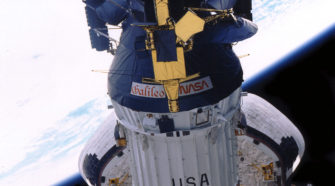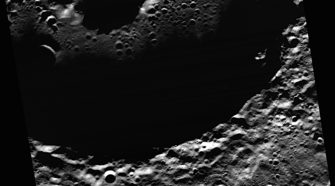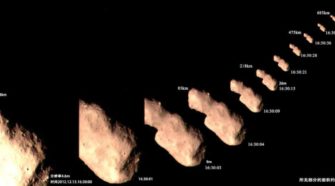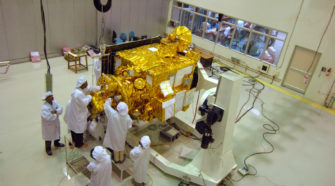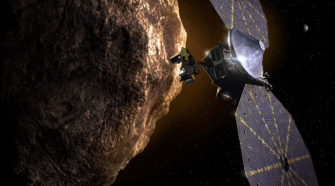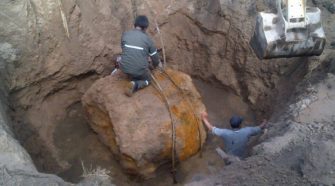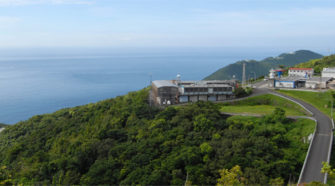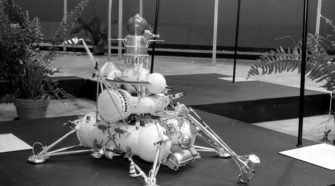History
This Week in History: October 18-24
OCTOBER 18, 1977: Charles Kowal discovers the first-known centaur, (2060) Chiron, with the 1.2-meter Schmidt telescope at Palomar Observatory in California. Centaurs are the subject of a previous “Special Topics” presentation. OCTOBER 18, 1989: NASA’s Galileo mission is deployed from the Space Shuttle Atlantis, with its final destination being Jupiter. While en route to Jupiter …
This Week in History: October 11-17
OCTOBER 11, 1983: The InfraRed Astronomical Satellite (IRAS) spacecraft discovers the “asteroid” now known as (3200) Phaethon. Phaethon had the smallest perihelion distance of any asteroid known at the time and was soon found to be traveling in the same orbit as the Geminid meteors, suggesting it may be their parent object and thus may …
This Week in History: October 4-10
OCTOBER 4, 2020: The main-belt asteroid (1679) Nevanlinna will occult the 7th-magnitude star HD 224945 in Pisces. The predicted path of the occultation crosses Newfoundland, part of the Maritime Provinces of Canada, the northeastern through the south-central U.S. (including Houston, Texas), north-central Mexico (including the northern regions of Monterrey, Nuevo Leon), and the southern Pacific …
This Week in History: Sept. 27-Oct. 3
SEPTEMBER 27, 1858: A British portrait painter and photographer, William Usherwood, takes a photograph of Comet Donati 1858 VI, the first photograph ever taken of a comet. No copies of Usherwood’s photograph are known to exist. Comet Donati is next week’s “Comet of the Week.” SEPTEMBER 27, 1990: The Hubble Space Telescope observes Comet Levy …
This Week in History: September 20-26
SEPTEMBER 21, 2012: Two amateur astronomers, Vitali Nevski of Belarus and Artyom Novichonok of Russia, discover Comet ISON C/2012 S1 with a telescope of the International Scientific Optical Network located at Kislovodsk, Russia. Comet ISON was expected to become a brilliant object when near the sun and Earth in late 2013 but instead disintegrated as …
This Week in History: September 13-19
SEPTEMBER 13, 1959: The then-Soviet Union’s Luna 2 spacecraft impacts the lunar surface slightly to the east of the Mare Imbrium. This was the first human spacecraft to reach the moon and the first spacecraft to impact another object in the solar system. SEPTEMBER 13, 1985: The U.S. Defense Department’s P78-1 satellite is deliberately destroyed …
This Week in History: September 6-12
SEPTEMBER 6, 1618: The German astronomer and mathematician Johannes Kepler observes Comet 1618 I (new style C/1618 Q1) – the first of three “Great Comets” that appeared that year – through a small telescope, the first recorded telescopic observation of a comet. SEPTEMBER 8, 1991: Tom Gehrels with the Spacewatch program in Arizona discovers the …
This Week in History: August 30-September 5
AUGUST 30, 1979: The SOLWIND coronagraph aboard the U.S. Defense Department’s P78-1 satellite records images of a bright comet approaching the sun, and then disintegrating. This comet, the first comet ever to be discovered from space, turned out to be a Kreutz sungrazer, and was the first of several comets discovered by SOLWIND prior to …
This Week in History: August 23-29
AUGUST 23, 1862: The comet now known as Comet 109P/Swift-Tuttle passes through perihelion at a heliocentric distance of 0.963 AU. The comet had been discovered the previous month independently by Lewis Swift and Horace Tuttle, and became a conspicuous naked-eye object. It is the parent comet of the Perseid meteor shower and is a future …
This Week in History: August 16-22
AUGUST 16, 1898: DeLisle Stewart at Harvard College Observatory’s Boyden Station in Arequipa, Peru, takes photographs on which Saturn’s outer moon Phoebe is discovered, although the images of Phoebe were not noticed until the following March by William Pickering. Phoebe was the first planetary moon to be discovered via photography, and it and other small …

